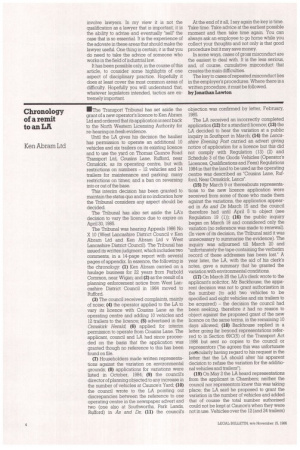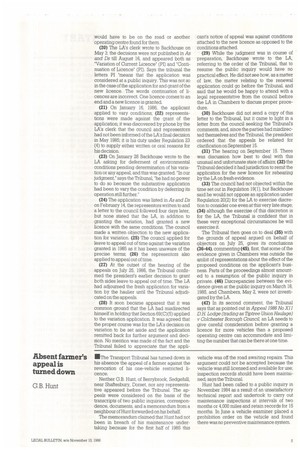Chronology of a remit to an LA
Page 46

Page 47

If you've noticed an error in this article please click here to report it so we can fix it.
Ken Abram Ltd
II The Transport Tribunal has set aside the grant of a new operator's licence to Ken Abram Ltd and ordered that its application is sent back to the North Western Licensing Authority for re-hearing on fresh evidence.
Until the LA gives his decision the haulier has permission to operate an additional 10 vehicles and six trailers on its existing licence and to use the yard on Thomas Caunce Road Transport Ltd, Cousins Lane, Rufford, near Ormslcirk, as its operating centre, but with restrictions on numbers 12 vehicles and 24 trailers for maintenance and parking; many restrictions on times; and a ban on reversing into or out of the base.
This interim decision has been granted to maintain the status quo and is no indication how the Tribunal considers any aspect should be decided.
The Tribunal has also set aside the LA's decision to vary the licence due to expire on Apri130, 1985.
The Tribunal was hearing Appeals 1986 No X 10 (West Lancashire District Council v Ken Abram Ltd and Ken Abram Ltd v West Lancashire District Council). The Tribunal has issued its written judgment, which includes two comments, in a 14-page report with several pages of appendix. In essence, the following is the chronology: (1) Ken Abram carried on a haulage business for 22 years from Parbold Common, near Wigan; and (2) as the result of a planning enforcement notice from West Lancashire District Council in 1984 moved to Rufford.
(3) The council received complaints, mainly of noise; (4) the operator applied to the LA to vary its licence with Cousins Lane as the operating centre and adding 10 vehicles and 12 trailers to the licence; (5) advertised in the Onnskirk Herald, (6) applied for interim permission to operate from Cousins Lane. The applicant, council and LA had since proceeded on the basis that the application was granted though no reference to this has been found on file.
(7) Householders made written representations against the variation on environmental grounds; (8) applications for variations were listed in October, 1984; (9) the council's director of planning objected to any increase in the number of vehicles at Caunce's Yard; (10) the council wrote to the LA pointing out discrepancies between the reference to one operating centre in the newspaper advert and two (one also at Southworths, Park Lands, Rufford) in As and Ds, (11) the council's objection was confirmed by letter, February, 1985.
The LA received an incorrectly completed application (12) for a standard licence; (13) the LA decided to hear the variation at a public inquiry in Southport in March; (14) the Lancashire Evening Post carried an advert giving notice of application for a licence but this did not comply with Regulation (13) (2) and Schedule 3 of the Goods Vehicles (Operator's Licences, Qualifications and Fees) Regulations 1984 in that the land to be used as the operating centre was described as "Cousins Lane, Rufford, Near Ormskirk, Lancs.
(15) By March 9 or thereabouts representations to the new licence application were received from some of those who made them against the variations, the application appeared in As and Ds March 15 and the council therefore had until April 5 to object (see Regulation 19 (1)); (16) the public inquiry began on March 18 and considered only the variation (no reference was made to renewal). (In view of its decision, the Tribunal said it was unnecessary to summarise the evidence). The inquiry was adjourned till March 20 and "unfortunately the tape containing the verbatim record of these addresses has been lost." A year later, the LA, with the aid of his clerk's notes, gave a summary that he granted the variation with environmental conditions.
(17) On March 25 the LA's clerk wrote to the applicant's solicitor, Mr Backhouse; the apparent decision was not to grant authorisation in the number (to add two vehicles to be specified and eight vehicles and six trailers to be acquired) the decision the council had been seeking, therefore it had no reason to object against the proposed grant of the new licence on the same terms, in the remaining 10 days allowed; (18) Backhouse replied in a letter going far beyond representations referred to in Section 69C(5) of the Transport Act 1986 but sent no copies to the council or representors ("he agrees this was unfortunate pacacularly having regard to his request in the letter that the LA should alter his apparent decision to refuse the variation for the additional vehicles and trailers").
(19) On May 2 the LA heard representations from the applicant in Chambers; neither the council nor representors knew this was taking place; the LA said he proposed to grant the variation in the number of vehicles and added that of course the total number authorised could not be kept at Caunce's when they were not in use. Vehicles over the 12 (and 24 trailers) would have to be on the road or another operating centre found for them.
(20) The LA's clerk wrote to Backhouse on May 3; the decisions were not published in As and Ds till August 16, and appeared both as "Variation of Current Licence" (PI) and 'Continuation of Licence" (PI). Says the tribunal the letters PI "means that the application was considered at a public inquiry. This was not so in the case of the application for and grant of the new licence. The words continuation of licences are incorrect. One licence comes to an end and a new licence is granted.
(21) On January 16, 1986, the applicant applied to vary conditions; (22) representations were made against the grant of the application; it was discovered by phone by the LA's clerk that the council and representors had not been informed of the LA's final decision in May 1985; it is his duty under Regulation 23 (4) to supply either written or oral reasons for his decision (23) On January 28 Backhouse wrote to the LA asking for deferment of environmental conditions pending determination of his variation or any appeal, and this was granted. "In our judgment," says the Tribunal, "he had no power to do so because the substantive application had been to vary the condition by deferring its operation still further."
(24) The application was listed in As and Ds on February 14, the representors written to and a letter to the council followed four days later, but none stated that the LA, in addition to granting the variation, had granted a new licence with the same conditions. The council made a written objection to the new application for variation. (25) The council applied for leave to appeal out of time against the variation granted in 1985 as it has been unaware of the precise terms; (26) the representors also applied to appeal out of time.
(27) At the outset of the hearing of the appeals on July 25, 1986, the Tribunal confirmed the president's earlier decision to grant both sides leave to appeal out of time. The LA had adjourned the fresh application for variation by the haulier until the Tribunal adjudicated on the appeals.
(28) It soon became apparent that it was common ground that the LA had misdirected himself in holding that Section 69(C)(5) applied to the variation application. It was agreed that the proper course was for the LA's decision on variation to be set aside and the application remitted back for further argument and decision. No mention was made of the fact and the Tribunal failed to appreciate that the appli cant's notice of appeal was against conditions attached to the new licence as opposed to the conditions attached.
(29) While the judgment was in course of preparation, Backhouse wrote to the LA, referring to the order of the Tribunal, that to resume the public inquiry would have no practical effect. He did not see how, as a matter of law, the matter relating to the renewal application could go before the Tribunal, and said that he would be happy to attend with a legal representative from the council before the LA in Chambers to discuss proper procedure.
(30) Backhouse did not send a copy of this letter to the Tribunal, but it came to light in a letter from the council seeking the Tribunal's comments, and, since the parties had misdirected themselves and the Tribunal, the president ordered that the appeals be relisted for clarification on September 15.
(31) The hearing on September 15. There was discussion how best to deal with this unusual and unfortunate state of affairs; (32) the Tribunal decided it had jurisdiction to remit the application for the new licence for rehearing by the LA on fresh evidence.
(33) The council had not objected within the time set out in Regulation 19(1), but Backhouse said he would not oppose an application under Regulation 20(2) for the LA to exercise discretion to consider one even at this very late stage; (34) although the exercise of this discretion is for the LA, the Tribunal is confident that in these very exceptional circumstances he will exercise it.
The Tribunal then goes on to deal (35) with the grounds of appeal argued on behalf of objectors on July 25, gives its conclusions (36-44), commenting (45), first, that some of the evidence given in Chambers was outside the ambit of representations about the effect of the proposed conditions on the applicant's business. Parts of the proceedings almost amounted to a resumption of the public inquiry in private. (46) Discrepancies between the evidence given at the public inquiry on March 18, 1985, and Chambers, May 2, were not investigated by the LA.
(47) In its second comment, the Tribunal says that as pointed out in Appeal 1986 No X11 D.H. Lodge (trading as Tiptree Union Haulage) v Colchester Borough Council, an LA needs to give careful consideration before granting a licence for more vehicles than a proposed operating centre can accommodate and limiting the number that can be there at one time.






























































































